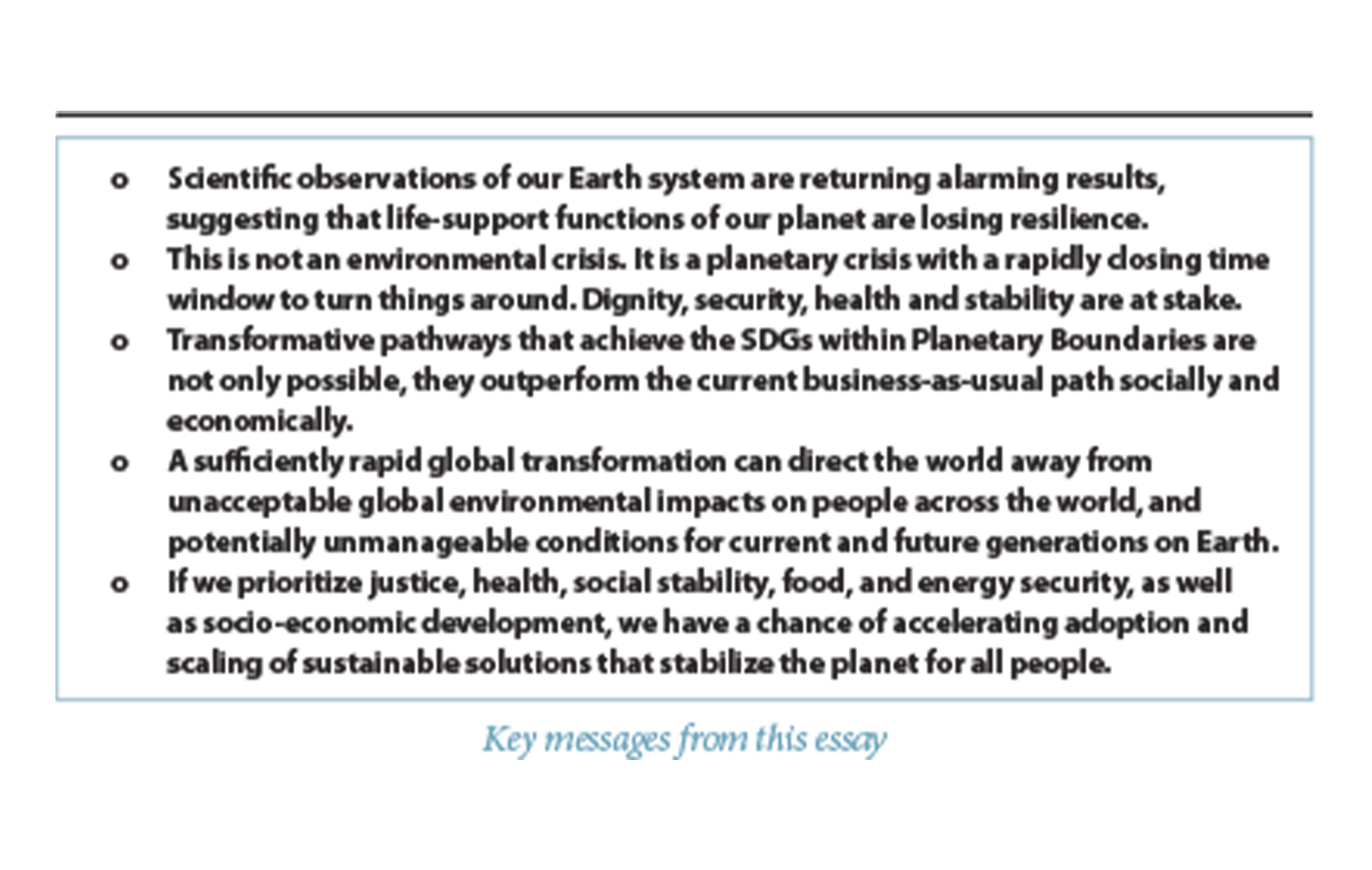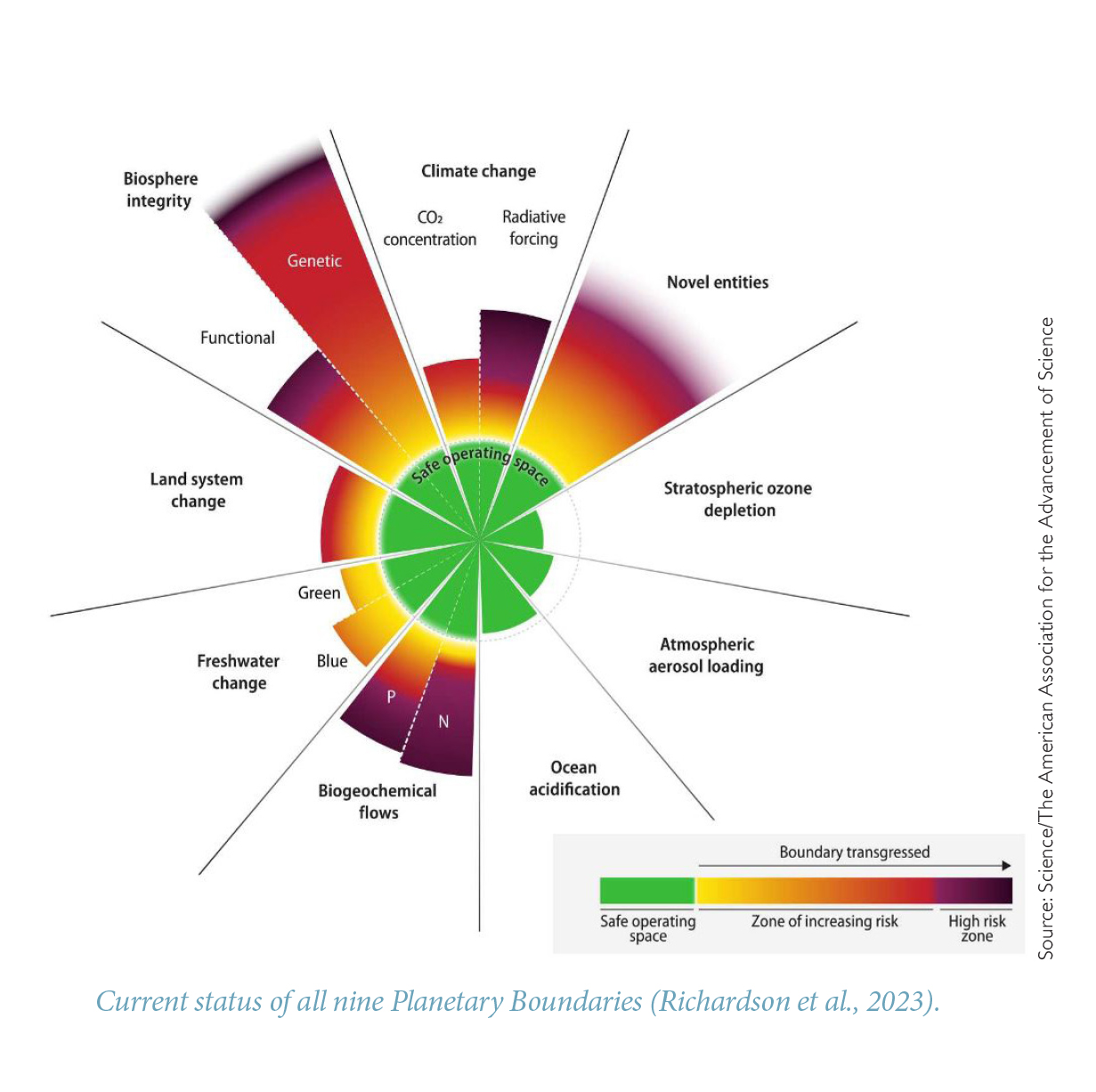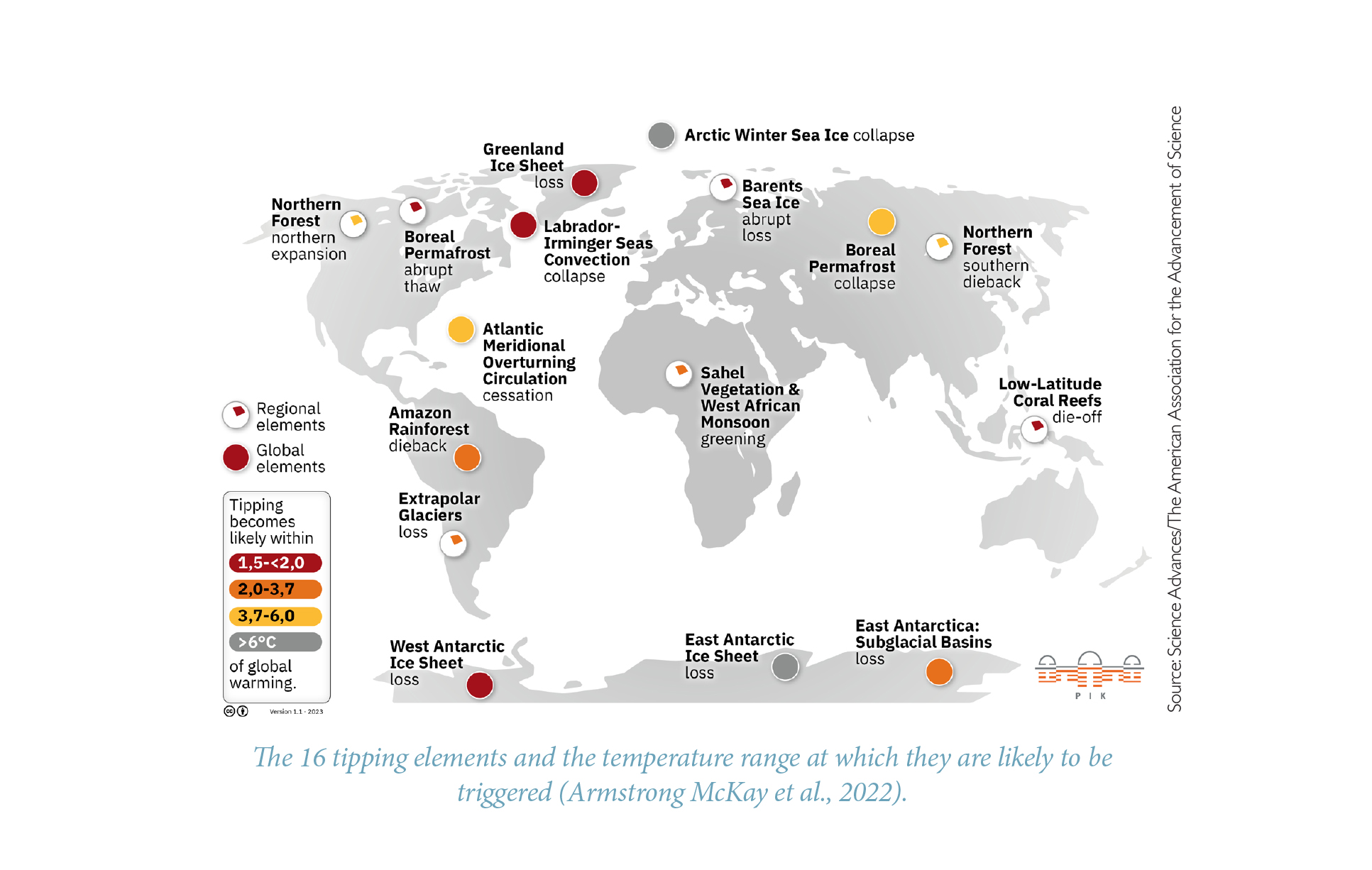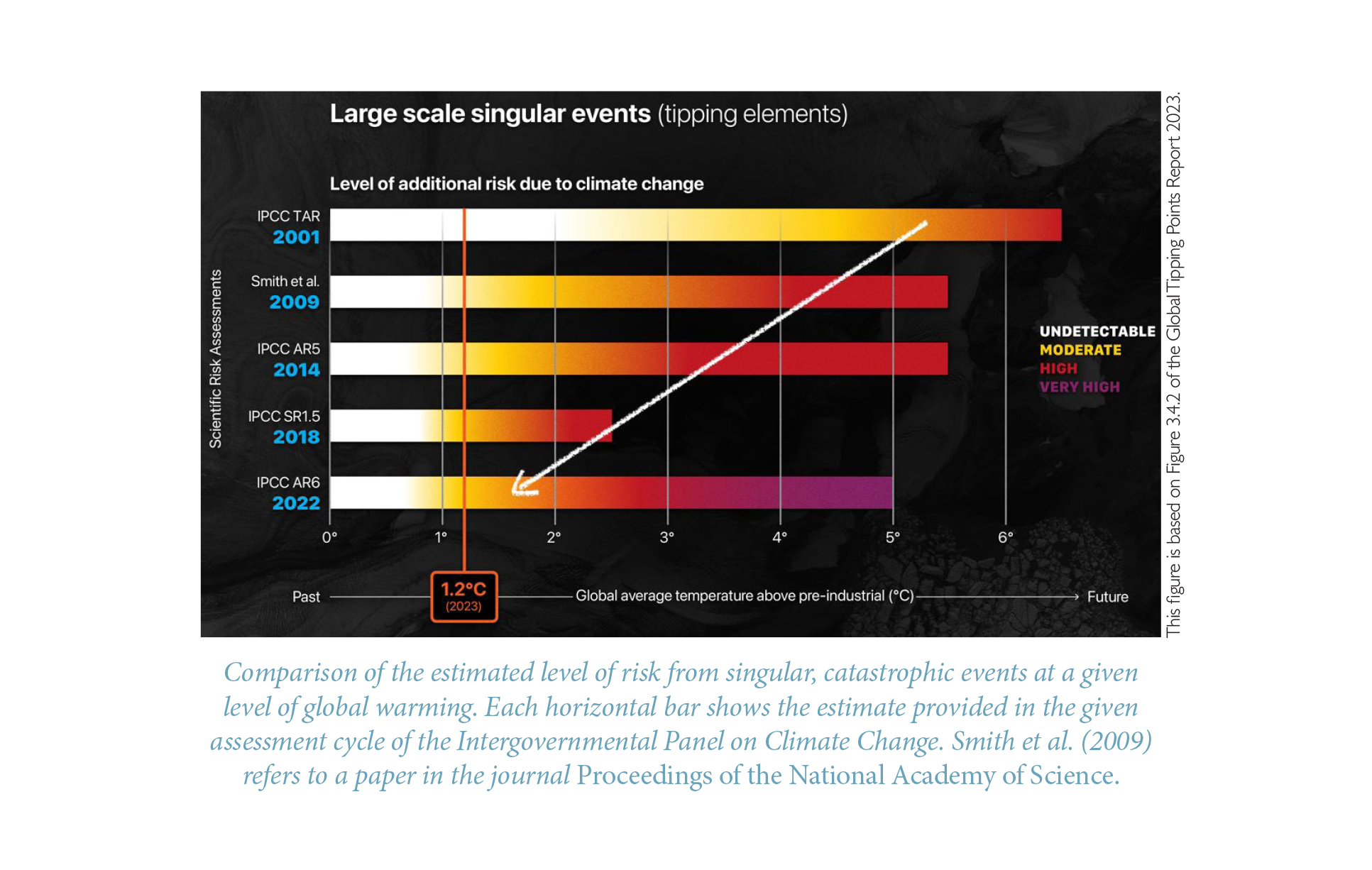

 Johan Rockström is Director of the Potsdam Institute for Climate Impact Research (PIK) and Professor in Earth System Science at the University of Potsdam. You may follow him on X @jrockstrom. Lila Warszawski is a post-doctoral Research Scientist at PIK and a Research Analyst for the Institute’s Director. Antonia Schuster is the Strategic Advisor to the Director of PIK.
Johan Rockström is Director of the Potsdam Institute for Climate Impact Research (PIK) and Professor in Earth System Science at the University of Potsdam. You may follow him on X @jrockstrom. Lila Warszawski is a post-doctoral Research Scientist at PIK and a Research Analyst for the Institute’s Director. Antonia Schuster is the Strategic Advisor to the Director of PIK.
During 2023 alone, our planet has provided us with dramatic insights into the extent of human-induced shifts in its self-regulating systems. Having almost brushed the 1.5°C guardrail in 2023, we are now getting a first taste of the future we have been collectively working to avoid. The list of record-breaking extreme weather events—ranging from extreme heat to unprecedentedly destructive floods and storms—is providing a window into the new normal.

Halfway through the decade in which the Sustainable Development Goals (SDGs) are slated for achievement, we must recognize that the only equitable and ethical path to these goals demands a stable Earth system. The wedding-cake model of thinking about the interconnections between the SDGs—in which the societal and economic goals are embedded in, and deeply dependent on, scientifically defined biosphere and climate targets—has never been more relevant. Formalized in the second review of the Planetary Boundaries, which Will Steffen, Katherine Richardson, Johan Rockström, and others published for Science in early 2015, is highly relevant due to the mounting scientific evidence of destabilization risks in the “bottom,” biosphere/climate layer of the cake, as well as the rising awareness of the pivotal role of economic and social development in addressing the climate and environmental crises.
In short, the message from science to the world is now loud and clear. There is no chance of achieving the social and economic SDGs—and ensuring dignified lives for all by eradicating poverty and hunger and enabling good socio-economic development—without securing the stability, resilience, and life-support systems of the planet.
The latest science, ranging from tipping point risks to Earth observations and rising severity of extreme climate events, shows that we are now so deep into the Anthropocene, and that the stability of the Earth system is seriously jeopardized. We entered the Anthropocene in the 1950s—the phase of human development when our modern world turned into the dominant force of change on the planet, as the Working Group on the Anthropocene, led by Jan Zalasiewicz put it in 2017. Will Steffen and colleagues described this moment as the “Great Acceleration,” with multiple “hockey sticks” of rapid rise in global environmental pressures, due primarily to rapidly changing economies and lifestyles in the global north. Seventy years into the Anthropocene, we can now say that the Earth has retained so much more energy than it has radiated back out to space, and lost so much resilience due to degraded biosphere functions (for example, changes in freshwater flows, loss of biodiversity), that Earth’s health is weakening. Furthermore, we appear to be committed to serious impacts of human-induced global change of the environment for at least 1000 years to come—as the group of scientists headed by Sofia Palazzo Corner claims. Our only chance to give current and future generations a hope of ethically defensible living conditions is to turn this unsustainable path around, and rapidly return to a safe operating space on Earth, guided by the principles of global justice and equality.
Whether in terms of staggering increases in sea surface temperature and accelerating mean global surface temperature, or signs of destabilization of tipping elements such as the Amazon rainforest or the Atlantic Meridional Overturning Circulation (AMOC), the scientific evidence is mounting that we can no longer exclude the risk of destabilizing the entire planet and are thereby putting Earth’s livability at risk. This message should be sounding alarms on all levels of community leadership, from local to multilateral. Any path towards a healthy, peaceful and dignified future for all people and the world at large—as well as any chance of delivering on the SDGs, buffering stress, and preserving the resilience to cope with intensifying extreme events—is conditional on safeguarding the stability and resilience of the entire planet.
The state of the planet must therefore become a pillar of all negotiations on global development, not least at the upcoming 2024 UN Summit of the Future. The alternative, if we continue to turn a blind eye to the planet, despite the human assault on its core biophysical fabric, is to pull the rug out from underneath the best-laid plans to secure a safe and dignified future for all humanity. This essay lays out the most compelling, robust, and relevant science on what we know about the current state of our planet, its likely development in the near term, and science’s best advice for Earth’s current and next generation of stewards.
A Health Check-up for Planet Earth
When the 2015 Paris Agreement was reached, all countries agreed to limit warming to 1.5°C average global mean surface temperature (GMST) above the pre-industrial (1850-1900) average. In 2023, according to data of the World Meteorological Organization, the 10-year moving average GMST reached 1.2+/-0.2°C. This is the warmest the Earth has been over the past 100,000 years, according to the Sixth Assessment Report of the Intergovernmental Panel on Climate Change (IPCC), and this heat is starting to cause major social and economic impact worldwide. In 2023, in part due to a human-amplified El Niño, the annual average GMST reached a record 1.48°C GMST. The World Meteorological Organization announced that the GMST during the 12 months from July 2023-June 2024 reached 1.63°C.
Indeed, we are following a path that will likely take us beyond 1.5°C within 10 years, breach 2°C by 2050 and reach 2.7°C by 2100. Although the 1.5°C limit in the Paris Agreement refers to a 20-year running average (a period that will include years with even higher average annual temperatures), today we are already getting a taste of a “1.5°C world.” To give just a few examples: the frequency of the most extreme wildfires on Earth have increased more than two-fold over the past 20 years, as Cunningham, Williamson, and Bowman note in their 2024 paper for Nature Ecology & Evolution. The year 2024 has likely seen the largest mass coral bleaching event ever within a 365-day period, further threatening the existence of ecosystems on which the livelihoods of hundreds of millions of people depend. And in 2023, the United States alone experienced a record 23 climate events resulting in damages in excess of $1 billion, as per the U.S. National Oceanic and Atmospheric Administration.
An additional, deeply concerning, trend is that the rate of global warming is accelerating. From 1970 to 2008, GMST rose by 0.18°C per decade. From 2014 onwards, as Piers Forster and others show in a 2024 paper, the rate has jumped up to 0.26°C per decade. This acceleration might be fueled by a combination of declining aerosol concentrations, higher-than-expected climate sensitivity combined with record greenhouse gas (GHG) emissions, the influence of El Niño, increased solar activity and volcanic eruptions. However, science cannot yet fully explain it. It is a further worrying sign of potential instability in the Earth system.
Trillion-Dollar Impacts on the Global Economy
Even at the current level of warming, the annual costs of climate change-fueled extreme weather are already running into the hundreds of billions of dollars. In 2023 alone, the Natural Catastrophe and Climate Report put the total economic costs of weather and climate perils at $301 billion.
Looking into the future, recent economic analysis conducted by Kotz, Levermann, and Venz, demonstrates that we are already today committed to an annual global loss of income of 19 percent of the global economy by 2050, corresponding to at least $38 trillion. Put another way, the social cost of carbon—the estimated economic damage that results from the emission of each additional ton of CO2—could be over $1000 per ton of CO2. This is many times higher than the world’s highest market price on carbon, which is $80-100 per ton of CO2 in the European Union’s Emissions Trading Scheme, demonstrating how societies, particularly future generations, are inadvertently shouldering the economic costs of cheap fossil fuel consumption.
Ninety percent of the heat caused by human GHG emissions is absorbed in the Ocean—von Schuckmann et al. find in a 2023 paper—making it a central pillar of resilience to distortions of the energy balance of our planet. Furthermore, around one quarter of anthropogenic CO2 emissions are sequestered in the ocean, according to 2023 findings by Pierre Friedlingstein et al. These are Earth’s largest dampening (cooling) factors (so-called negative feedback). Over the last four decades, with the rising energy imbalance due to global GHG emissions, ocean temperatures have risen by about 0.6°C and about 0.9°C since pre-industrial times. That marine systems are increasingly subject to stress is a worrying but well-understood phenomenon. However, in 2023 sea (ocean) surface temperature jumped markedly by almost 0.3°C in just a year, as noted by the Copernicus Climate Change Service. In 2024, the trend away from historic values has continued unabated. We did not see this coming: such an increase has not been predicted by the world’s most trusted climate models, and clear explanations are yet to emerge. Could it be that the enormous ocean heat sink is starting to show signs of instability? Science has not yet provided a definitive answer, but it is unequivocally a reason for concern.
Earth Resilience
One reason the observations in the ocean are so worrying is that they add to a growing chorus of similar signs in other systems on Earth. In the relevant past, these systems have dampened the advancement of global warming, but are now showing signs of shifting to amplifying feedback behavior. The big concern here is the deterioration of the capacity of natural systems to absorb carbon on many fronts. This ‘service’ is usually taken for granted, but in its absence, the natural world becomes a climate change accelerator, rather than providing resilience against it.
We have increasing scientific evidence that forests, including the world’s largest forest biome, the boreal forests in the Canadian and Russian Arctic, or the temperate mixed forests from Germany to Russia, are losing their carbon uptake capacity, as McDowell et al. worryingly point out in a 2020 paper for Science. Driven by deforestation and climate change, the southeastern part of the Amazon Rainforest has tipped over from being a carbon sink, to now being a net carbon source. Apart from being one of the world’s most biologically diverse regions, the Amazon is now a net contributor to climate change.
Polar ice sheets and inland glaciers are melting fast, causing shifts in reflectivity of incoming solar radiation (shift in Albedo towards darker surface colors), thus absorbing more heat from the sun. Permafrost is warming globally, raising fears of the release of large amounts of the GHG methane through the thawing of organic matter.
These are all signs of a planet under stress—a planet that is losing its resilience. Indeed, six of nine Planetary Boundaries that regulate stability, resilience, and human life-support on Earth are now transgressed (see Figure 1). We are not only breaching the climate boundary, we are also breaching the boundaries of land use change, freshwater use, biodiversity loss, overloading nutrients (nitrogen and phosphorus), and the overloading of novel entities (human-created chemical pollutants). This means that in the midst of the climate crisis, we are undermining the capacity of the living biosphere to buffer the strain caused by the GHG-driven global energy imbalance.
A more holistic view reveals an even more worrying picture: halfway into the decisive decade for having a chance to meet global environmental targets (e.g. limiting warming to 1.5°C and halting biodiversity loss) and achieving the SDGs, the physical planetary crisis is playing out in the context of significant global turbulence. Multiple systemic disruptions are hitting societies across the world simultaneously, ranging from armed conflicts, geopolitical turbulence, and social instability, to economic recession, and continued risks related to the global health crisis. A global poly-crisis, where systemic risks interact and reinforce each other, can no longer be excluded, as a group of researchers led by Michael Lawrence argued in a 2024 paper published by Cambridge University Press.

Moving Rapidly Towards Tipping Points
Climate change, nature loss, and pollution are gradually eroding Earth’s resilience, and pushing us closer to tipping points. The most recent science—published by Armstrong McKay and a group of scholars in 2022 for Science magazine—shows that we are likely to cross multiple tipping points already at 1.5°C (see Figure 2). The IPCC has confirmed the existence of 16 tipping element systems, and concluded that the risk of triggering irreversible changes is likely already between 1.5°C and 2°C. Currently, in the Holocene (the state of the planet since we left the last Ice Age 11,000 years ago), most tipping element systems are dominated by negative feedback that dampens warming caused by increasing GHG concentrations. If tipping points are crossed, feedback shifts from dampening to amplifying.
In the case of the Greenland Ice Sheet, the stable Holocene state reflects about 90 percent of incoming solar radiation back into space (due to its highly reflective white surface). As it melts, the darker liquid surface will absorb an increasing amount of heat. A tipping point is crossed when more heat is absorbed than reflected. The ice sheet transitions to unstoppable melting and shifts from cooling to warming the planet. The Greenland Ice Sheet alone contains enough water to raise sea levels by about seven meters in the long term. It would not suddenly raise global sea levels the moment the tipping point is crossed, but the rate of melting would increase, and, above all, the melting would be unstoppable.
Based on the most up-to-date scientific survey (by Armstrong McKay et al.), the following tipping elements are likely to cross tipping points already at 1.5°C: Greenland Ice Sheet, West Antarctic Ice Sheet, Permafrost (abrupt thawing), Tropical Coral Reef systems and the Labrador Current (collapse). This provides strong scientific support that holding global warming to 1.5°C, as stipulated in the Paris Climate Agreement, is not a political goal or target, it is a physical limit. It also implies that the legally binding temperature limit in the Paris Agreement of holding global warming “well below 2°C” must be understood to mean 1.5°C.
The fact that each of the tipping elements is part of the same, interconnected Earth system presents the real possibility that crossing one tipping point sets off a tipping ‘cascade.’ Recent scientific results—published in early 2024 by Wunderling, Heydt, Aksenov, and others for Earth System Dynamics—are showing that these (mostly) destabilizing interactions between tipping elements may further lower the global temperature rise at which there is a high risk of tipping.

Underestimating Risk
Even though science clearly articulates a significant risk of destabilizing the life-support systems on Earth, there is still good reason to believe we are actually underestimating risk by not considering interactions between different sources of risk. The Amazon rainforest is a pertinent example where the impacts of climate change coupled with those of other forms of environmental degradation lead to a higher risk of catastrophic change than when each risk factor is considered separately. Due to climate alone, we estimate the risk of tipping at 3-5°C, but if we factor in massive deforestation (causing loss of canopy cover which “dries out” the system), we cannot exclude tipping already at 1.5-2°C if we lose 20-25 percent of the forest cover, as Lovejoy and Nobre argued in 2018 for Science Advances. We are today at 1.2°C and 17 percent forest loss. The conclusion? When factoring in the interaction of multiple planetary boundaries (climate, water, land, and biodiversity), the scientific assessment is that we are very close to a tipping point in the Amazon basin.
Indeed, if we look at the conclusions of the IPCC over the past six reporting cycles on the risks associated with singular, catastrophic events (i.e. tipping elements), it becomes clear that the more we understand about these tipping elements, the higher the risk becomes at a given level of global warming (see Figure 3). Some 20 years ago (at the time of the IPCC’s Third Assessment Report release in 2001), a high risk of triggering irreversible changes in the climate system was assessed to occur only above 5-6°C of global warming. In other words, the risk was essentially zero at the time. Five assessment reports later, the risk of crossing tipping points is already significant within the 1.5-2°C range. The more we learn about the complex interactions in the Earth system, the more reason for concern.

Pathways to a Manageable Future
Not only are the SDGs supposed to be achieved during this decade—eradicating poverty and hunger and providing conditions for a dignified life for all—but it is in this decade that we need to succeed with a transformative turnaround. The curves of global environmental change must all bend and be significantly reduced by 2030 in order to halt the loss of Earth resilience. In a transition phase these major shifts (from fossil-fuel based to green energy and from linear to circular economies) will be challenging, with winners and losers, and accompanied by large (solvable) social equity challenges. But without this turnaround, the prerequisites for the SDGs themselves will remain elusive. The global GHG emissions must be cut by half by 2030. Biodiversity loss must be halted and we must start regenerating nature, not further weakening Earth’s life support systems. Almost five years into the SDG-Turnaround decade, and we must acknowledge that six of nine Planetary Boundaries are breached, and global GHG emissions have yet to definitively peak.
As GHG emissions continue unabated, the latest assessment shows that the remaining global carbon budget to have a 50 percent chance of staying below the 1.5°C limit has rapidly declined from 500 GtCO2 in the IPCC AR6 (budget as of 2020), to a remaining budget of around 200 GtCO2 in the middle of 2024 (MCC Berlin). Global emissions continue rising (albeit only at approximately one percent a year), when they actually need to be cut by more than 7 percent a year. This means we continue to emit approximately 40 GtCO2 per year, primarily from burning oil, coal, and gas, which leaves around five years at the current rate of emissions until the budget is consumed (and we forfeit the chance of remaining below 1.5°C).
An orderly phase out of fossil-fuels, respecting the remaining budget, translates to the scientifically defined pathways of cutting global emissions by 50 percent (compared to 2020 levels) by 2030, and continuing to cut emissions by at least one half each decade, to reach a net-zero world economy no later than 2050, as some of us have already argued before (Rockström 2017). This must be accompanied by significant decreases in non-CO2 GHGs (most importantly methane) and the preservation and ongoing restoration of natural carbon sinks.
Overshoot of 1.5°C is Inevitable
As two of this essay’s authors pointed out in a 2021 paper for Environmental Research Letters, avoiding a temporary overshoot of 1.5°C is practically infeasible. From where we stand in 2024, those assertions are a virtual certainty. This means that at best—i.e. we phase out fossil-fuels by 2050, halt the degradation of nature, phase out non-CO2 GHGs, and ensure no tipping points are crossed—we will very likely breach 1.5°C, and have 30 to 40 years of overshoot (exceeding 1.5°C by somewhere between 0.1 and 0.3°C) before potentially landing back at 1.5°C of GMST by the end of this century. This is what the only realistic IPCC scenarios show.
We know with great certainty that this means rising frequency and strength of extreme events. We are inevitably facing 30-40 years of rising climate damage to societies across the world. We will be exceeding the likely threshold for tipping elements including coral reef systems, the great ice sheets, and permafrost thawing, to shift state from “dampening” to “amplifying.” Science does not have an answer to whether these tipping elements will weather a period of overshoot.
That the overshoot is just temporary and that the global temperatures will return below 1.5°C after the stated 30-40 year period is not a given. The climate models show that once GHG emissions are turned off, temperatures will gradually decline, as carbon is absorbed in the biosphere on land and in the ocean. Our only chance to increase the capacity of the Earth system to maintain this buffering service to humanity—absorbing carbon dioxide and heat that would otherwise contribute to warming the planet—is to return to the safe operating space of all Planetary Boundaries.
More specifically, the only way of securing a future as close as possible to 1.5°C by the end of the century after overshoot is to: (i) decarbonize the global economy at record pace to limit the maximum temperature of the overshoot, and (ii) return back within all the Planetary Boundaries that provide Earth’s resilience. In other words, there is no accomplishment of the Paris Climate Agreement, and there is no SDG delivery, unless we also return within the safe Planetary Boundaries for a resilient and stable planet.
This also means that for any sector in society, be it aviation, ground transport, the food industry, retail, or tech, business models and value chains must be aligned with scientifically defined boundaries that take into account the entire Earth system. It is not enough to focus only on fossil-fuel phase out, taking a “climate-only” approach. Taking aviation as just one example: biomass-based jet fuels, a potential “green” substitute for conventional jet-fuels from fossil resources, cannot be evaluated simply on their contribution to reducing GHGs. The associated freshwater consumption, biodiversity loss, use of biomass, and land-use change must also be part of the overall picture.
Such a holistic approach to environmental protection must be developed with guidance from the scientific community. Conceptual frameworks such as the Planetary Commons, developed by one of this essay’s authors and a group of colleagues, suggest how the existing global commons (an international judicial framework that governs the use of globally-shared geographic regions) can be augmented to safeguard critical biophysical regulating functions, not just geographic regions, in order to return within Planetary Boundaries. The Planetary Commons are envisioned to define comprehensive stewardship obligations through Earth system governance aimed at restoring and strengthening planetary resilience and justice.
Safeguarding the Planetary Commons is not just of concern to conservationists or those geographically close to them. We all depend on them. Residents of Hong Kong, Abidjan, or Texas, all depend equally on the health of the ice sheets and the big forest systems. Jeopardize them and the ripple effect throughout the Earth system (through damaging feedback) will reduce livability globally. This is, in fact, the definition of Planetary Commons.
Linear Change is No Longer an Option
Shifts need to be systemic and occur across the global economy at a record pace. This demands that sectors with already mature markets and institutions operating in the global economy—such as energy utilities, financial institutions, food industry, land/sea/air transport—collaborate in pre-competitive arrangements that set global “rules of the game.” Without being exhaustive, these should include a global price on carbon (of at least $100 per ton of CO2), phase-out dates for conventional fuels, and investments in R&D for innovation pathways towards alternative, Planetary Boundary-aligned fuels and circular material use.
Given the pace and scale of change required, the only way of succeeding is to ensure that the sustainable “offer” is more attractive in terms of prosperity and equity. “Green” solutions, when implemented with concern for humanism and environment along the entire economic chain, are not only good for the planet, they are increasingly competitive (without subsidies), technologically more advanced, and thus modern and attractive, with well established benefits for health, security, and social stability. Advancing along the path to a safe landing within Planetary Boundaries is the most important narrative required to unleash the innovations, leadership, and civil engagement required to tip the scales towards global sustainability.







